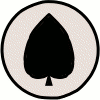| 12th (Eastern) Division | |
|---|---|
 | |
| Active |
First World War: August 1914–22 March 1919 Second World War: 1939–1940 |
| Country | United Kingdom |
| Branch | New Army |
| Type | Infantry |
| Engagements | Battle of Epehy |
The 12th (Eastern) Division was a division raised by the British Army during the First World War.[1] It was disbanded during the Second World War due to the number of casualties that it took.
Formation and First World War[]
The 12th (Eastern) Division, was one of the Kitchener's Army divisions raised from volunteers by Lord Kitchener. It was formed within Eastern Command as a result of Army Order No. 324 of 21 August 1914, as part of the K1 wave of divisions.[2] It fought on the Western Front for the duration of the First World War. One of its most notable actions was the Battle of Epehy where there is a memorial cross to the Division.
In the First World War, the division's insignia was the Ace of Spades.
Second World War[]
The Division was reformed as a second line Territorial Army formation just before the start of the Second World War, a duplicate of the 44th (Home Counties) Division. As such it contained mostly half trained units, some of whom had not even fired their rifles. In April 1940 the 12th Infantry, along with the 23rd (Northumbrian) Division and 46th (North Midland) Divisions, were sent as lines of communications troops to France.[3] They were all under-equipped and did not have their signals, Royal Artillery or administrative units with them.
When the German Army attacks began on 10 May 1940 only every third battalion had done a week's training. As a result, the 12th Infantry suffered heavy casualties during the Battle of France and the subsequent retreat to and evacuation from Dunkirk.
As a result of its high proportion of casualties (the 36th Infantry Brigade having been severely mauled on 20 May 1940) the 12th Infantry Division was disbanded on 11 July 1940. However, two of its constituent brigades, the 36th Infantry Brigade and the 35th Infantry Brigade would see service later in the war, the 35th as 169th Infantry Brigade, with the 56th (London) Division, and the 36th with the 78th Infantry Division
First World War structure[]
- 35th Brigade
- 7th The Norfolk Regiment
- 7th The Suffolk Regiment
- 9th The Essex Regiment
- 5th Princess Charlotte of Wales's (Royal Berkshire Regiment)
- 1/1st Battalion, The Cambridgeshire Regiment
- 36th Brigade
- 8th Royal Fusiliers (City of London Regiment)
- 9th Royal Fusiliers (City of London Regiment)
- 7th The Royal Sussex Regiment
- 11th The Duke of Cambridge's Own (Middlesex Regiment)
- 37th Brigade
- Pioneers
Second World War Order of Battle[]
France 1940
- 35th Infantry Brigade
- 2/5th The Queen's (Royal West Surrey Regiment)
- 2/6th The Queen's Royal Regiment
- 2/7th The Queen's Royal Regiment
- 36th Infantry Brigade
- 5th Royal East Kent Regiment
- 6th The Queen's Own Royal West Kent Regiment
- 7th The Queen's Own Royal West Kent Regiment
- 37th Infantry Brigade
- 6th The Royal Sussex Regiment
- 2/6th The East Surrey Regiment
- 7th The Royal Sussex Regiment
The 37th Infantry Brigade was a duplicate of the 133rd Infantry Brigade, and was re-created on 7 October 1939. In France it was nearly completely destroyed fighting the German invasion. It was reorganised as the 7th Infantry Brigade (Guards) on 8 December 1941.
From 7 October 1939 to 25 October 1939 5th Battalion Royal East Kents (The Buffs) was also part of 37 Infantry Brigade.[4]
The Divisional formation badge of the Ace of Spades has since been adopted by 12 Mechanised Brigade (United Kingdom).
See also[]
- List of British divisions in World War I
- List of British divisions in World War II
- British Army Order of Battle - September 1939
Notes[]
- ↑ Beckett 2008, and other authoritative references, refer to this formation as '12th (Eastern) Division'. No mention of 'Infantry.' Beckett 2008, 128
- ↑ The British Army in the Great War: The 12th (Eastern) Infantry Division, accessed October 2009
- ↑ Beckett, 2008, 128.
- ↑ http://www.ordersofbattle.com/UnitData.aspx?UniX=1897, accessed November 2011
References[]
- Maj-Gen Sir Arthur B Scott and P. Middleton Brumwell, 'History of the 12th (Eastern) Division in the Great War', Nisbet & Co, London, 1923
- Ian F.W. Beckett, 'Territorials: A Century of Service,' First Published April 2008 by DRA Printing of 14 Mary Seacole Road, The Millfields, Plymouth PL1 3JY on behalf of TA 100, ISBN 978-0-9557813-1-5.
External links[]
- Source for level of Training of 12th Inf.Div.
- 12 (Eastern) Infantry Division at Orders of Battle.com
The original article can be found at 12th (Eastern) Division and the edit history here.